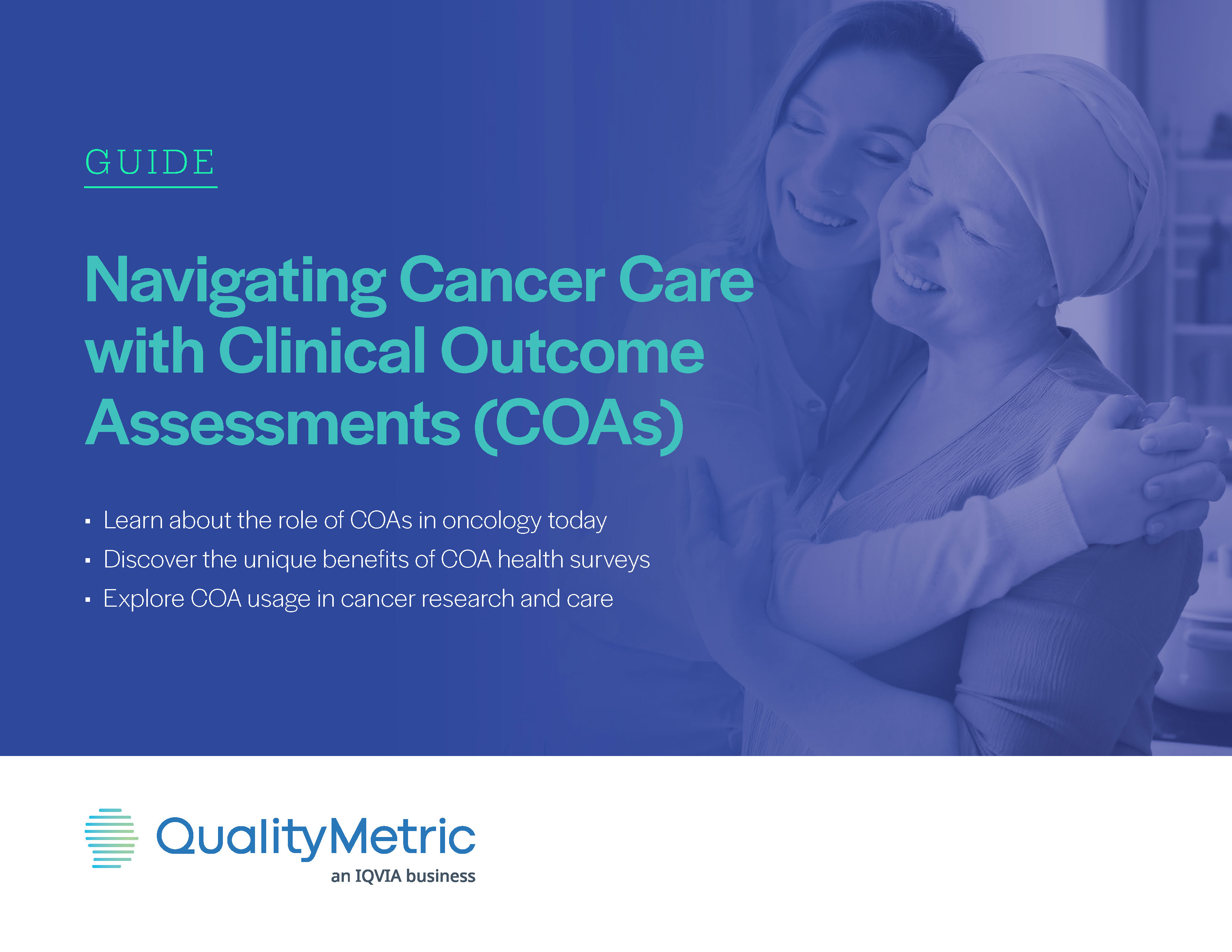
Using PRO Measures in Amyloidosis Research
Amyloidosis refers to a group of rare diseases caused by the buildup of misfolded proteins in various tissues and organs in the body, often leading to organ damage and impaired quality of life. 1Given the rareness of systemic amyloidosis, there can be limited opportunities to gather data on the daily impact of the disease and available treatments. But with an end-to-end approach—using patient-reported outcome (PRO) measures paired with the expertise of a scientific partner like QualityMetric—more researchers are able to understand the disease’s natural history, assess clinical outcomes including treatment efficacy and effectiveness and characterize patient experiences.
Learn how PRO measures can support the study and development of amyloidosis treatments through clinical trials, observational studies and other applications.
What is Amyloidosis?
Amyloidosis or amyloid disease is a group of rare diseases characterized by misfolded proteins (such as transthyretin or immunoglobulin light chain) that accumulate in organs or tissues like the heart, kidney, nerves, liver and gastrointestinal system.1
More than thirty proteins have been identified as being amyloidogenic in humans amyloidosis; the most common forms include transthyretin (ATTR), immunoglobulin light chain (AL) and serum amyloid A (AA or secondary amyloidosis) amyloidosis.3
Patients’ symptoms vary within and across different types of amyloidosis depending on the affected organs and can include arrhythmia, fatigue, shortness of breath and swelling or pain in the hands, legs, ankles, feet or abdominal areas, although the disease presentation and patient experience vary depending on affected areas of the body.2
There is currently no cure for any type of amyloidosis, but those with the disease may receive chemotherapy, medication or other forms of treatment to manage the chronic, life-threatening condition.

How PRO Measures Support Amyloidosis Research
PRO measures are questionnaires about health designed to be completed by a patient to capture their assessment of how well (or poorly) they are doing. PRO measures focus on the symptoms patients experience and/or how their disease impacts their daily life and functioning, often referred to as health-related quality of life (HRQoL). Using self-directed PRO measures, patients with amyloidosis can share their personal experiences and help researchers, healthcare professionals, caregivers and other patients understand how amyloidosis affects HRQoL.
HRQoL & PRO Measures
Historically, researchers have used well-validated PRO measures like QualityMetric’s SF-36v2® Health Survey in combination with other PRO measures to examine HRQoL in amyloidosis (e.g., quality of life in patients with ATTR4 and employment patterns and impact on work in patients with AL amyloidosis5).
Uncovering the impacts of amyloidosis on HRQoL through PRO measures not only informs the initial assessment of an individual’s overall health status but may also:
- Describe the natural history of the disease and identify unmet needs
- Contribute to treatment efficacy and burden of disease analysis
- Enable comparisons between various treatment outcomes
- Help evaluate treatment benefits against health costs and utilization
- Generate evidence for new therapy label claims and marketing efforts
- Meaningfully engage patients in their amyloidosis management
A recent study on the relationship between hematologic response and changes in HRQoL among patients with AL amyloidosis sought to ultimately examine the degree to which this frequently used clinical marker encapsulates the patient experience.6
It found that achieving a complete hematologic response does not necessarily lead to increased or stable HRQoL; treatment may be considered successful from a hematologic perspective, but still leave patients at risk for declines in HRQoL.6
The research concludes by emphasizing the importance of assessing outcomes from multiple perspectives—including the patient’s—to gain meaningful insights into AL amyloidosis. PRO measures can obtain that patient perspective for a clearer picture of disease, treatment and patient status.
While generic PRO measures, or a mix of measures intended for various conditions related to amyloidosis (e.g., cardiomyopathy), have been used successfully to document HRQoL in patients with amyloidosis, a need does exist for instruments that accurately represent and measure the concepts most important to patients.

Development of an ATTR-Specific PRO Measure: The ATTR-QOL Questionnaire
For years, QualityMetric has supported the advancement of amyloidosis research as part of the Amyloidosis Forum—a public-private partnership between the Amyloidosis Research Consortium (ARC) and the FDA to advance drug development. It has seen great success in partnering with pharmaceutical companies and patient advocacy groups to measure patient experiences with immunoglobulin light chain (AL) amyloidosis using the SF-36v2®.
Recently, QualityMetric, along with the Amyloidosis Research Consortium (ARC), developed the Transthyretin Amyloidosis Quality of Life (ATTR-QOL) Questionnaire, an ATTR-specific PRO measure designed to provide a more standard, consistent and comprehensive way to measure outcomes in ATTR clinical trials and clinical practice.7 The ATTR-QOL was developed using insights from patients with ATTR, patient organizations, clinicians, researchers and drug developers in the United States.
The ATTR-QOL asks patients to report on their recent ATTR-related symptoms and the ways in which ATTR has impacted their HRQoL, including impacts on physical, role and mental/emotional functioning.
With an ongoing iterative process to triangulate results from factor analysis with evidence of psychometric properties and feedback from qualitative researchers and clinical experts, QualityMetric and ARC are finalizing the measurement’s structure and share additional recommendations for ATTR-QOL items and recommended scoring.
As more sponsors and investigators leverage the ATTR-QOL and further validate this important instrument, the ATTR community will gain access to information that may change patients’ lives for the better.
Partner with QualityMetric for rare disease expertise that can help your team use PRO measures for rare disease research and evidence generation. Interested in exploring PRO measures on your own? Browse our suite of patient-reported outcome assessments.
References
- Rare disease database: Amyloidosis. National organization for rare disorders (NORD). 2023. https://rarediseases.org/rare-diseases/amyloidosis/#disease-overview-main
- McCausland KL, White MK, Guthrie SD, et al. Light chain (AL) amyloidosis: The journey to diagnosis. The Patient – Patient-Centered Outcomes Research. 2018;11:207-216. https://doi.org/10.1007/s40271-017-0273-5
- Picken, MM. The Pathology of Amyloidosis in Classification: A Review. Acta Haematol.2020;143(4): 322-334. https://doi.org/10.1159/000506696
- Aimo A, Rapezzi C, Perfetto F, et al. Quality of life assessment in amyloid transthyretin (ATTR) amyloidosis. Eur J Clin Invest. 2021;51(11):e13598. https://doi.org/10.1111%2Feci.13598
- Rizio AA, McCausland KL, White MK, Quock TP. Work Outcomes Among Patients with Light Chain (AL) Amyloidosis: Findings from Three Patient Cohorts. Patient Related Outcome Measures. 2021;12:339-347. http://dx.doi.org/10.2147/PROM.S337676
- Rizio AA, McCausland KL, Carty MK, Conrad A, Quock TP. Association Between Hematologic Response and Change in Health-Related Quality of Life Among Patients with Light-Chain (AL) Amyloidosis. Patient Relat Outcome Meas. 2023;14:297-304. https://doi.org/10.2147/PROM.S421211
- O’Connor M, Hsu K, Broderick L, et al. The transthyretin amyloidosis – quality of life (ATTR-QOL) questionnaire: Development of a Conceptual model and disease-specific patient-reported outcome measure. Patient related outcome measures. 2023;14:213–222. https://doi.org/10.2147/PROM.S411721
 NEW COAS IN ONCOLOGY GUIDE
NEW COAS IN ONCOLOGY GUIDE



